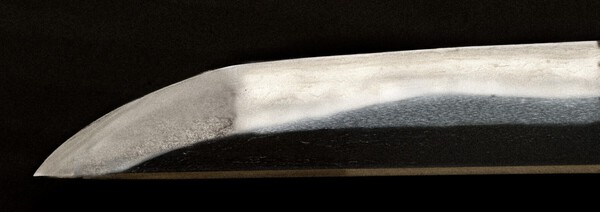-
Posts
2,348 -
Joined
-
Last visited
-
Days Won
19
Content Type
Profiles
Forums
Events
Store
Downloads
Gallery
Everything posted by Rivkin
-

Shinshinto- Gendaito periods inaccurate?
Rivkin replied to jdawg221's topic in General Nihonto Related Discussion
There are conflicting opinions about recent work since after 1980s the economy of swordmaking has been slowly declining. But they are better. Early Showa is not impressive outside of a few names. Actually for better or worse post 1960 works tend to be really similar to shinshinto in stylistics. A bit artificial, harsh, strong lined, but bright and rich. -

Shinshinto- Gendaito periods inaccurate?
Rivkin replied to jdawg221's topic in General Nihonto Related Discussion
Very few only smiths who can be seen as extension of shinshinto, for example Gassan. The rest started anew with random steels and strange styles, only in late 1930s you start having Shibata Ka and other smiths who to an extent restore the tradition. Still, until 1970-1980s probably the quality was two grades below shinshinto. -

What happens to collectons?
Rivkin replied to Peter Bleed's topic in General Nihonto Related Discussion
Should I pay attention to this? Everytime I think about it, the answer is "I don't know". Alien society and people, alien manners... who am I to judge? Observed ill intent or impropriety might exist only in the reflection of our self-absorption. Certainly, few today understand what swords really signify. Born in a society which believes the history ended in 1945, the "history" being kind of unenlightened insanity, at best accepted through preservation. The best recent deathbed treatment given to a sword was by Mishima. Strange, out of place, "pointless", yet undeniably beautiful and in many ways proper for the sword, proper for the smith. Like Kondo Isami honoring Kotetsu, anyone using an old blade, or any blade at all should consider the responsibility. If he is a warrior whose fame will endure for centuries, fire burial with a beloved blade is proper and will honor the blade and the smith. If one is to slaughter hundred enemies, it honors both the blade and the smith. Use the old blades. Make your deeds worthy. -

What happens to collectons?
Rivkin replied to Peter Bleed's topic in General Nihonto Related Discussion
Who knows if a sword, or its previous owner, prefers the thing stored in a safe or dying while doing what it was created to do. I don't. But I would certainly prefer to be killed by a quality blade rather than an ugly mass produced crap covered with machine oil. Unless its important historically... It has importance as a link of warrior cultures, past and present. And I heard you are not supposed to own mumei shinto and shinshinto anyway. -

What happens to collectons?
Rivkin replied to Peter Bleed's topic in General Nihonto Related Discussion
If the blade has limited cultural or artistic value... Wotanists/Valhallists do burn bodies with swords and other weapons. Conversely when fighting or decapitating someone, it is proper to use an even better weapon, in the very least to show respect. Would not use koto for either of these purposes, but a shinto blade, why not. We will all die, and so will all the swords. Naturally they will much later than us, but then to go off in battle is a great honor. -

Thoughts and Attributions on an O-Suriage'd Wakizashi
Rivkin replied to Marcus Devonport's topic in Nihonto
He was not particularly known for bo utsuri, it sort of overall Muromachi trait, somebody copied from some book. Its all hair splitting since they are very similar, but with Oei Morimitsu and alike you don't expect groups of the same height, 4 elements+. You expect large choji-gunome joined with a few others, quite a bit more non-uniform appearance. Strong groupings with flat hight/similar width are associated with Eikyo-Onin-Bunmei pieces. But they very seldom have midare utsuri shooting to shinogi and ashi tend to start closer to the edge, overall hamon can be narrower on average. Sanemitsu did flat height large grouping with very wide and expressive hamon, with some ko nie sprinkled around the hamon's upper portion. Its a good match. -

Thoughts and Attributions on an O-Suriage'd Wakizashi
Rivkin replied to Marcus Devonport's topic in Nihonto
The most likely bet is Oei Bizen Sanemitsu. -

Thoughts and Attributions on an O-Suriage'd Wakizashi
Rivkin replied to Marcus Devonport's topic in Nihonto
It is excellent. It can be many things, but my feeling this is Oei to Bunmei Bizen. It kind of wants to be Saburo, but the groupings are too distinct, sort of Muromachi broad boshi... But this is great. -
Most Go that I've seen that "widened" hamon, noticably did so within 10 inches below kissaki. The width variation exists, though noticably less pronounced compared to say Kaneuji, and it occurs differently compared to other schools - with particularly long "wide" areas. Hope this helps.
-
Not the image I am particularly proud of, but shows the general gist. AOI's Tametsugu definitely has this Go widening and Ichimai, but very tired, jigane is gone, nie is rough... But a very rare type of "Tametsugu" with Go features, indeed.
-
It is sort of Soshu, but first and foremost what is Ichimai boshi and what is "attributed" are not perfectly defined terms. In textbook pictures you see fully and uniformly hardened kissaki with nioi-guchi located outside yokote. This is rare. And if you see Go where hamon starts to widen before kissaki and then the entire kissaki is hardened - its ichimai, and the papers typically say simply "Go". Sayagai might say "kiwame Go". Then there are pieces where it widens or not before the kissaki, but within the kissaki the hamon is simply very wide, nie+nioiguchi covers 85% of kissaki area, but there is certainly some "empty space" left out. Then the papers might as well say "Den Go". The percentage of Ichimai boshi for Go strongly depends on whether you include "Den Go". But then a dealer also can describe the wide hamon as ichimai, it happens all the time.
-

What happens to collectons?
Rivkin replied to Peter Bleed's topic in General Nihonto Related Discussion
The better the items the more effort is spend by the owner to find a single buyer-collector and make the arrangements. If the collection is not only good, but specialized, there is a high chance this happening. In which case the sale often goes with a premium compared to the market price. It is a singular chance to make such acquisition and the buyer is aware of that. If it does not happen, it goes either to dealer who might offer a lump sum (20-60% of the expected), or they sell over many years. Or it goes into auction. Christies and Sotheby have less problems securing good submission, but smaller auctions like Rock Island can sometimes offer exceptional incentives and have pre-arranged bidders, so they end up handling the sale. Sometimes the sale is completely private - they send catalogue to 3-5 people, they immediately submit bids and the matter never gets into the room. Public sales have many issues, there are always "rumors" about pieces left with nonsense descriptions on purpose, bidders who collectively agree on bids versus bidders who purposefully drive up bids on items they know will sell at some significant premium etc. etc.. For certain subjects, auctions are chaos few understand, but in every sale there is a lot going on. They get strong feedback when working on the catalogue, another feedback when they see the bids. At all times going private or splitting the collection is an option they consider. Reasonably good collection was placed on sale and they got very high bids on items they did not think much about from a person they respected. They got really scared, pulled out half the auction, sold the stuff nobody cared much about, and offered everything else privately. -

Why i dislike this dealer
Rivkin replied to lonely panet's topic in Auctions and Online Sales or Sellers
Another discussion that goes somewhere. I know a few dealers whom I reasonably trust on descriptions, photography and moneyback guarantee. I never bought much from them - they deal in things somewhat outside my interest. On the other hand Christies are awful in photography, descriptions, no warranty, false promises, random people. I bought from them and many people do. Because they have a brand and good items. Simply don't pay attention to most things they write down. There are more dangerous guys, those who do put in the effort when writing things, but either far more incompetent than they think they are (99% of dealers), or they are shrewd. Or both. Yes, Aoi Art has a thingy where they affix a koshirae to most blades they sell. I loved it as a beginner (its a real samurai sword), less than thrilled now, but there is some match between blade quality and koshirae, and even at the bottom its not "awful-awful". Big thoroughput shop with many good items. -
To an extent yes, you do see some Soshu imitations in shinto which used it, but not a typical choice. It is also seldom though a bit more often used in shinshinto, also Soshu imitations.
-
Usually it is, like Go, but it does not determines the school all by itself.
-
The blade is in polish. It might be not the best, but its a relatively recent job. Hada is opening, as on many Muromachi pieces, and is rather unsightly. Otherwise, it is Soshu, with very long muneyaki and relatively quiet hamon, which could be lesser senjo or something like Masahiro lineage. The nakago's rather sharp tapering would lean towards the former, but there is a weird outline "jump" when it starts to narrow down, might be nothing, might be it has been reworked from a more broad version... I would get papers first. It is a big question if another polish will substantially improve anything and there is one place where hamon runs very close to the edge, if not passes it. Still, it is late Muromachi Soshu, quite possibly Masahiro or Senjo school.
-
No, I was saying Muromachi additionally. It can still be 19th century, but I am more inclined to guess (there is really little), its earlier. Regarding polish - these blades need to be studied in hand, before that very light oil cover could be applied.
-
Unfortunately both out of polish, so its next to impossible to say something. They are bother either o-kissaki or extended chu kissaki, which suggests shinshinto, Momoyama or Nambokucho. The one where we can see the hamon looks a bit like Mino or Bizen from Muromachi, so might be Momoyama of this school. The one with hi - the hi is not the best cutting job I've seen, but the blade itself might be either of these three options, or less likely something else. It does not look very beefy, so also might be koto. If one is lucky even Nanbokucho, but there is zero polish so no idea.
-

Increasing Gold Membership numbers?
Rivkin replied to Brian's topic in General Nihonto Related Discussion
In the old times some forums would offer a physical "forum pin" for premier members to wear at sword shows etc.. -
Yamamura is an underappreciated smith and can be a great value. He and Nobukuni and Etchu Kuniyuki are very similar; Etchu will be darker and more hitatsura-like, Yamamura will have lighter steel and more Nobukuni hamon. There are a few generations [?] and Oei one is at the same level as Nanbokucho. But this example is at its end. Otherwise you should get something like this.
-

Increasing Gold Membership numbers?
Rivkin replied to Brian's topic in General Nihonto Related Discussion
Special finger option for platinum members! I like your unconventional thinking. -

Hitler's Samurai rare original Booklet by Heinz Corazza
Rivkin replied to Volker62's topic in Military Swords of Japan
I already mentioned it once I think, but I was involved in briefly assessing foreign ministry property which was taken as Soviet trophy. 90% was Chinese gifts from early and pre-Hitler period - vases, plaques, some artwork, contemporary or early XXth century items. There was surprisingly little Japanese. -
Seeing boshi in details would really help this one. There is potential.
-
Nihonto community is very cliquey, some groups don't like some dealers. Aoi Art is a big volume dealer and a lot of people use it, but all dealers are dangerous. On the blade - this is classic Yamamura, alternative judgement would be like Etchu Kuniyuki. Its late Nambokucho. Very tired.






.thumb.jpg.37bd9c646ee0a2b48e4385b15e095ee4.jpg)

